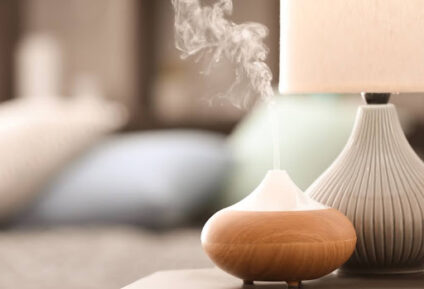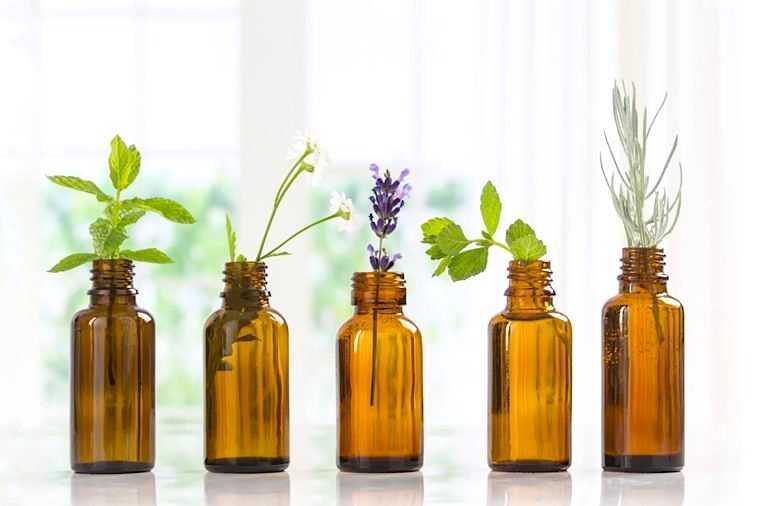Aromatherapy Diffusers
The most common piece of equipment used with aromatherapy is a diffuser, which disperses essential oils into the air.
Here is a brief overview of four types of common diffusers along with the benefits of each:
Ultrasonic Diffusers
Ultrasonic diffusers use electronic frequencies to create a fine mist from a mixture of essential oil and water. The mist is then expelled to fill a room with the aroma of the essential oils used.
Benefits:
- Humidifying Effect: Great for dry climates or dry winter months, as they add moisture to the air.
- Energy Efficient: Uses minimal electricity.
- Quiet Operation: Ideal for use in bedrooms or quiet spaces.
- Safe to Use: The diffuser does not rely on heat, making it safe to use around children and pets.
Nebulizing Diffusers
Nebulizing diffusers work by using pressurized air to diffuse a mist of pure essential oil into the air. This type of diffuser does not use water or heat.
Benefits:
- Strong Concentration: Provides a more potent aroma, ideal for larger spaces or for a more intense aromatherapy experience.
- Heat-Free: Maintains the therapeutic properties of essential oils by avoiding heat.
- No Water Needed: Directly uses essential oils, which can be more cost-effective in the long run.
Heat Diffusers
Heat diffusers use heat to gently warm the essential oil, releasing its fragrance into the air. They can be electric or use a candle as the heat source.
Benefits:
- Silent Operation: No moving parts, making them extremely quiet.
- Affordable: Generally cheaper than ultrasonic or nebulizing diffusers.
- Simple to Use: Easy operation without the need for water or complicated settings.
Evaporative Diffusers
Evaporative diffusers work by evaporating the essential oils into the air, often using a fan to speed up the process. This can include simple setups like a bowl of warm water with essential oils or more complex fan-assisted devices.
Benefits:
- Portability: Often battery-operated, making them easy to move from room to room.
- Ease of Use: Simple technology that’s straightforward to use and maintain.
- Immediate Effect: Quickly disperses the scent throughout the room, making it effective for immediate relief.
Non-Diffuser Options
If you don’t have access to a diffuser, other methods include direct inhalation, aromatherapy candles, baths or applying oils topically when properly diluted with a carrier oil.

Aromatherapy Oils: Where to Start
There are many different aromatherapy scents available, each serving a specific function. Let’s look at some of the more commonly used oils and the purpose they serve.
5 Beneficial Essential Oils for a New Home
- Lavender is known for its calming and relaxing properties, perfect for creating a peaceful atmosphere.
- Lemon’s refreshing and purifying qualities can help eliminate odors and bring a sense of cleanliness.
- Peppermint is energizing and invigorating. Peppermint can help boost energy levels when unpacking.
- Eucalyptus is great for purifying the air and promoting clear breathing.
- Tea Tree is known for its antimicrobial properties, ideal for sanitizing your new space.
3 Calming Aromatherapy Oils for Stressful Moves
- Frankincense offers relaxation and grounding.
- Chamomile is known for its calming effects. It’s especially good for stress and anxiety relief.
- Ylang-Ylang helps in reducing tension and relaxing sore muscles.
How Do I Use Aromatherapy Oils?
To get started, choose a quality diffuser and select the essential oils that appeal to you. Begin by using your diffuser in a well-ventilated area, following the manufacturer’s instructions. Use a small amount of oil initially; you can always add more if needed.
Potential Issues with Allergies or Side Effects
While natural, essential oils are potent and can cause side effects or allergic reactions in some people. These may include rash, asthma, headache, nausea and skin irritation. Be sure to conduct a patch test before using a new oil topically and to dilute oils appropriately with a carrier oil. If you experience any adverse reactions, discontinue use and consult a healthcare provider.
Frequency of Use
Aromatherapy can be enjoyed as often as daily, depending on your needs and preferences. It’s important to listen to your body and the responses of those living with you to find a balance that works for everyone.
Aromatherapy for Dogs and Other Pets
Pets can be more sensitive to essential oils than humans. Some oils can be toxic to pets, especially cats. It’s crucial to research and consult with a veterinarian before using aromatherapy around your furry friends. Always ensure the room is well-ventilated and that pets have the option to leave the area where oils are being diffused. See ASPCA’s post for more information.
Storing Your Supplies
Store your essential oils in a cool, dark place, away from direct sunlight. This helps preserve their potency and extend their shelf life. Make sure the caps are tightly sealed to prevent oxidation.
Take a Deep Breath After Moving
Aromatherapy can be a wonderful addition to your new home. By selecting the right oils and using them safely, you can create a serene and healthy environment for you and your loved ones. Another way to take the stress out of your move is to use the professional movers at Bekins. Connect with Bekins today to get started with your hassle-free move.

